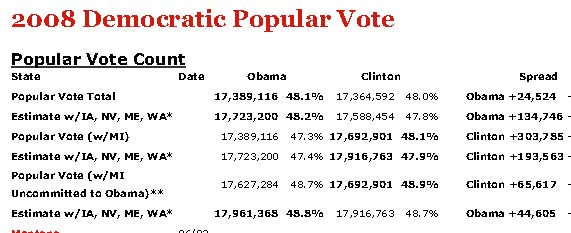Back to that question of who has more of the popular vote, Obama or
Hillary: Realclearpolitics, has the following table:
 |
| Popular Vote |
The top heading "Popular Vote Total" is the popular vote excluding
Michigan. The third and fourth lines include Michigan, unmodified. The
fifth and sixth lines include Michigan, but with 100% of the Uncommitted
vote going to Obama.
The second, fourth, and sixth lines include estimates of the popular
votes in the caucus states of Iowa, Nevada, Maine, and Washington.
But as
Talkleft points out, there is still another wrinkle to the
definition of "popular vote": states which have both caucuses and
primaries, where the caucus determines who gets the delegates, but the
primary has more voters expressing a preference for a candidate.
Nebraska, Idaho, and Washington both had primaries as well as caucuses. It seems
reasonable to include them if we are measuring popular votes cast either
literally or to see which candidate has more support among voters.
Including them helps Hillary and hurts Obama. I use numbers from
Talkleft.
Nebraska had a primary in May, as well as its earlier caucuses which
actually chose the delegates (see here for a news
story).
Nebraska had 38 thousand caucus votes and 95 thousand votes in its
May primary. In the caucuses, Obama beat Hillary 68% to 32%, 26 to
12 thousand, a 14 thousand margin. In the primary, Obama beat Hillary
49.4% to 46.6%, 47 to 44, a 3 thousand margin. Replacing caucus with
primary results adds 11 thousand to Hillary's total popular vote.
Washington had 238 thousand caucus votes and 691 thousand votes in its
February primary (on which, see here). In the
caucuses, Obama beat Hillary 67% to 31%, 159 to 74 thousand, an 85
thousand margin. In the primary, Obama beat Hillary 51% to 45%, 352
to 311 thousand, a 41 thousand margin. Replacing caucus with primary
results adds 44 thousand to Hillary's total popular vote.
In Idaho, Obama had a 13 thousand vote lead in the caucuses, but only 8 thousand in the primary.
Replacing the Washington and Nebraska and Idaho caucus results with primary
results thus helps Hillary by 60 thousand votes. The spreads in
RealClearPolitics's 6 categories change to
Clinton +36 thousand
Obama +74
Clinton +363
Clinton +2538
Clinton +125
Clinton +16
Thus, the only definition of these, once Nebraska and Washington popular
votes are included, by which Obama wins is if we exclude the Michigan
primary and include estimates from the 4 caucus states.
Of course, all of these vote totals are very close, as are the
delegate totals. Their main importance in my opinion is as a gauge of
how much each candidate appeals to voters, and really we should weight
the later primaries more heavily in measuring that. For someone who
believes in "count every vote", though, the popular vote is crucial,
more important perhaps than the vote allocated by the rules.
Speaking of the rules, the Democratic National Committee ruling today
puzzles me. It seems blatantly illegal. The DNC has said that delegates
from Michigan and Florida will only get 1/2 vote each. That's fine---
those states broke the rules. But it is also allocating the Uncommitted
vote in Michigan to Obama, giving him the delegates based on that. Since
the voters voted for Uncommitted, not Obama, how can those delegates
possibly be committed to vote for Obama? The same result could have been
achieved by picking allowing the Obama camp to pick the delegates but
leaving them formally uncommitted, but why wasn't that done? Or *is*
that how it was done?
Labels: elections, obama
![]()
![]()


